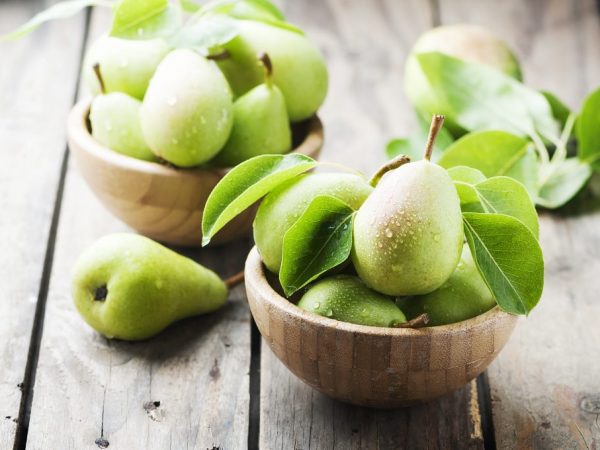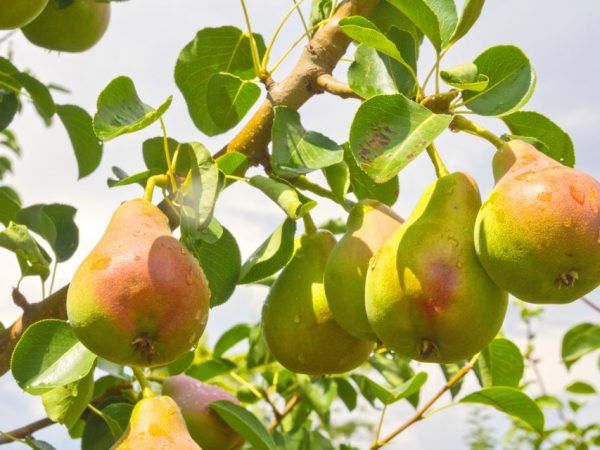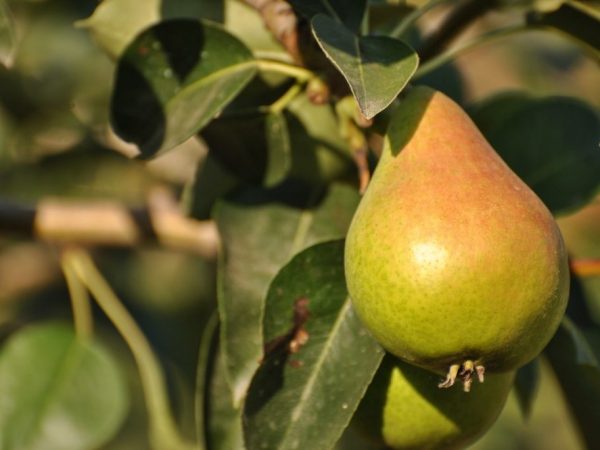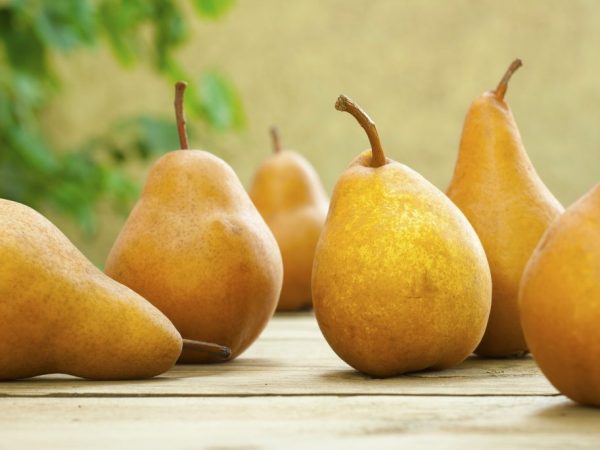The best autumn, summer, winter pear varieties
Breeders create the best pear varieties, which are divided into categories according to ripening time, yield level, and growing area. They differ in taste and appearance of fruits and trees.

Description of the best varieties of pears
Summer varieties
Summer pear varieties bear fruit from early July to late August, which is why they are also called early ripening. They are distinguished by a long shelf life of ripe fruits: from 17 to 30 days. It is important that they are stored in a cool place: in the basement, cellar, refrigerator. Their only drawback is poor frost resistance. Early ripe pear varieties are grown after frost, otherwise the tree will die.
Characteristics of summer varieties of pears:
- a high level of fruiting (from 70 kg to 100 kg of pears from 1 tree);
- resistance to fungal infections;
- preservation of taste and aroma during storage.
Early maturing trees should not be grown in the Urals and Siberia. But in the central part of Russia and in the middle lane, this is a great option.
August dew
August dew is distinguished by low-growing trees. Their height does not exceed 2 m. The taste of the fruit is sweet and sour. They are green in color, which turns yellow during storage. Medium size, no ribs.
According to the description, the variety is grown only in the central regions of Russia. The variety does not tolerate temperature extremes and frosts, which is why it can die. Requires basic maintenance procedures: watering, fertilizing, warming for the winter, mulching, loosening the soil.
Another advantage of wood is scab resistance. It is also moderately resistant to fruit rot and powdery mildew.
Bere (Giffard)
The height of the tree is not less than 3-5 m. It has excellent branching. The branches are thin, drooping. The Bere tree begins to bear fruit on ringlets.
Fruits are yellow-green in color, when technical maturity is reached - red-yellow. The fruiting period begins on July 17-21 and lasts until the end of the month. The fruits are harvested daily so that they do not rot and spoil.
The only drawback of the Bere (Giffard) variety is the short storage time (up to 15 days) in comparison with the average statistical indicator of 17-30 days, therefore, the fruits of this variety are not suitable for transportability.
Description of Bere (Giffard) fruits:
- the pulp is wine-sweet, aromatic, tender;
- weight - from 70 g to 110 g;
- the surface is smooth;
- the shape is aligned, sometimes asymmetric;
- small subcutaneous points;
- long stalks;
- closed cup.
The plant bears fruit 6 years after planting. The yield level is average - 90-100 kg from 1 pear tree.
Cathedral

Fruits are kept fresh for a long time
The fruits of the Kafedralnaya variety are valued for their pleasant sweet taste. The pulp has an oily consistency, fine granularity. The density level of pears is medium. Inside, they are juicy and meaty.
The average weight of 1 cathedral pear is 70-90 g. In some cases it reaches 110-120 g. The shape of the fruit is regular, with a slight bumpy surface.
The skin is shiny, slightly oily, has a reddish-yellow color, but during storage changes it to light yellow with a blush.
The fruits are harvested from 1 to 15 August. They can be stored for 1-1.5 months, perfectly tolerate transportation and do not deteriorate on the road.
The yield level is low - about 80 kg per tree. But the main thing is that the Cathedral pear bears fruit regularly 4 years after planting.
Victoria
The pear grows up to 5 m in height, has a thickened, but compact crown with a rounded pyramidal shape. During the flowering period, it is covered with white and pale yellow flowers. Harvesting takes place in mid-late August, so the variety is late.
Fruits grow up to 150-200 g in weight, rarely up to 300 g. They are symmetrical, aligned, have a regular pear-shaped shape. Their skin is smooth, matte, with few fibers.
Description of Victoria pear pulp:
- white;
- oily;
- tender;
- no granulation;
- juicy.
The fruits have a pleasant aroma. The taste is sweet, but slightly sour. 100 g contains 13% solids, 7.8% sugar, 0.5% titratable acids, 6 g of ascorbic acid.
Winter varieties
Winter varieties of pears are excellent for growing in Siberia and other northern regions, as well as for planting in the central part of and central Russia.
Such pears are the most winter-hardy, they perfectly tolerate temperature extremes. The fruiting period is from November to February, depending on the type of fruit tree. The yield level is up to 300 kg per tree.
Characteristics of winter varieties:
- Long shelf life. Winter pears do not spoil for 3 to 7 weeks. The indicator is influenced by storage conditions and characteristics of the fruit variety.
- Less sweet taste. The taste is dominated by sourness, but the sweetness is also preserved. Despite this, the fruit contains many useful chemical elements that have a positive effect on the digestive tract.
- Use for recycling. Fresh are rarely used, most often they are processed. They make excellent dried fruits and compotes.
The peculiarity of the fruits of winter pears is that they cannot be eaten immediately after harvest. They should lie down in a cold place for at least a week. You can understand that they are ready for use by their appearance: the skin will acquire a light yellow tint, a ruddy side will appear. The fruit will become softer and less sour.
The fruits require a mulching procedure. It is held at the end of November. To do this, use mulch paper, straw, rotted grass, etc.
Curé

The Cure variety is distinguished by its yield
It belongs to the category of early winter varieties. It is defined as a tree with a highly thickened crown, so it requires frequent pruning to form the correct shape. The plant is tall - up to 8 m in height.
The fruits ripen alternately, and not at one moment, starting from the top and gradually moving downward. The tree bears fruit in September 20-25. One pear weighs up to 190 g, rarely up to 250 g.
At the time of harvest, the fruits are bright green, have a smooth skin, no blush. The pulp is hard inside, but oily, with a nutmeg aroma.
Usually the Kure pear gives up to 300 kg of fruit, but in productive years - up to 700 kg from 1 tree. It bears fruit even after severe frosts and droughts.
November
A vigorous dwarf plant. Its height does not exceed 2 m. The branching is small. The branches are directed downward under the weight of the fruit. Yields are low
Fruits weigh 60-80 g. Covered with a light red blush. When harvested, they have a rich green hue.
Other characteristics of the November pear:
- the pulp is white, juicy, buttery;
- the skin is glossy, shiny;
- the taste is sweet, but with a slight sourness;
- The aroma is pleasant, reminiscent of the smell of a blossoming apple tree.
The fruits can be frozen. They are used for cooking compotes, added to smoothies, fresh juices, diet cocktails. They are the base in marshmallow or decoration in pies.
Harvesting takes place after September 25th.Fruits are stored until early December at a cold temperature.
Helena
This variety has the most unusual pear shape. They resemble an apple.
The plant is early winter, frost-resistant. Begins to bear fruit in the 5th year after planting. It produces fruits regularly, annually. The harvest period is the end of September.
It is important to have time to collect ripe fruits within 10-15 days, otherwise they will start to rot, due to which the plant will be exposed to rot. Stored up to 4 months.
The average weight of the fruit is 150-200 g. Skin color is green with a slight blush.
Due to its good composition, the fruits are allowed to be consumed even by young children. They are hypoallergenic, so the likelihood of an allergic reaction is low.
Olivier de Serre
This is the sweetest variety of late winter pears. It is distinguished by small fruits, all of each fruit - up to 130 g. They have a rounded shape. There is a brown coating on top, under which a green skin is visible. It is rough, dense.
Description of the pulp Olivier de Serre:
- cream;
- juicy;
- melts in the mouth;
- has a sweet almond, nutty flavor;
- fleshy;
- consists of a variety of dietary fiber.
Even if it is not possible to collect the fruits in time, they will not fall off: they are firmly attached to the stalks.

The variety is prized for its excellent taste.
Harvested in mid-October, but consumed only in December. It is necessary that they stay in bed for 2 months. They are stored until the end of March.
They are eaten fresh, used for baking, dried and preserved.
Autumn varieties
Autumn varieties are grown throughout Russia. The main thing is to choose the right soil. A cultivated loamy soil with low acidity is suitable (if it is high, liming is carried out). The landing site must be sunny, but staying in the shade for about 2-3 hours is allowed.
To grow a high-yielding tree, the following procedures are carried out:
- watering;
- pruning branches to form a crown or rejuvenate the pear;
- loosening the soil;
- fertilization;
- disinfection from pests (preventive measures);
- mulching;
- frost protection.
Fruits are harvested until the end of September, rarely until October. The average yield is equal to 100 kg of fruit from 1 plant. The trees are winter hardy in most cases.
Red-sided
The tree grows to a maximum of 4 m. It grows actively for the first 4 years, after which the growth process slows down. The crown is rare, but spreading. The branches are curved. The bark is brown, gray on the branches.
Krasnoboka has mixed fruiting. The fruits are formed on the spears.
The plant necessarily requires pollinators to set and form fruit. Pears Severyanka, Myth, Powislaya are suitable.
Fruit varieties Krasnobokaya are the sweetest among all the autumn varieties of fruit. They are used for drying, preservation, preparation of compotes. Fresh added to fruit salads, marshmallows, ice cream, cottage cheese, pies. Red-sided fruits make excellent sweet wines.
Daughter of Blankova
This is a mid-autumn variety. The plant is tall - up to 10 m. The crown is pyramidal, narrow. Suitable for growing in the middle lane.
The trees of Daughter Blankova are winter-hardy. They are able to withstand temperatures down to -25 ° C. Fruiting occurs in the 5-6th year.
The fruits do not fall off immediately, but hold firmly to the tree, have a green-yellow color, blush is rare.
Other characteristics of Daughter Blankova:
- average yield - up to 90 kg from 1 tree;
- harvesting takes place in late August and early September;
- consumer maturity occurs 10 days after harvesting the fruit.
Fruits weigh from 80 to 120 g, have a blunt-conical shape. The skin is thick, dense, matte. The pulp is juicy, sweet, with a weak pear aroma.
Michurinsk beauty
This is a hybrid bred from the Ussuriiskaya and Dekanka winter varieties. The plant is dwarf, it grows up to 1.5-2 m. The crown does not differ in thickening.
Average weight of fruits - 100-120 g.The color is light green, but with a pronounced blush on the sunny side. The pulp is juicy, fleshy, creamy, without granulation. Due to this, the harvest of Michurinskaya beauty has a pleasant sweet taste.
The advantages of the variety:
- resistance to scab and fungal diseases;
- no need for pollinators;
- regular fruiting, starting from the 4th year after planting;
- undemanding care.
Conclusion
Pear varieties are most often distinguished by the fruiting period: there are summer, autumn, winter. There are no special differences in care and planting. They are manifested in the selection of soil, climatic conditions and the appearance of the fruit.

